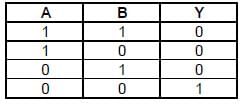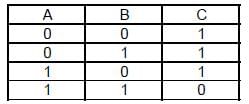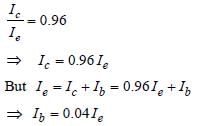31 Year NEET Previous Year Questions: Semiconductor Electronics - 3 - NEET MCQ
25 Questions MCQ Test - 31 Year NEET Previous Year Questions: Semiconductor Electronics - 3
The following truth table belongs to which of the following four gates? [1997]


A semi-conducting device is connected in aseries circuit with a battery and a resistance. Acurrent is found to pass through the circuit. Ifthe polarity of the battery is reversed, the currentdrops to almost zero. The device may be
| 1 Crore+ students have signed up on EduRev. Have you? Download the App |
The transfer ratio β of a transistor is 50. Theinput resistance of the transistor when used inthe common emitter configuration is 1 kΩ. Thepeak value of the collector A.C. current for anA.C. input voltage of 0.01 V peak is [1998]
Which of the following gates will have an output of 1?

(a)

(b)

(c)

(d)
The truth-table given below is for which gate? [1998]

The cause of the potential barrier in a p-n diodeis [1998]
In forward bias, the width of potential barrier ina p-n junction diode [1999]
A depletion layer consists of [1999]
Which of the following when added acts as animpurity into silicon produced n-type semiconductor? [1999]
In a junction diode, the holes are due to [1999]
A gate has the following truth table

The gate is
In the study of transistor as amplifier, if  and
and  , where, IC, IB and IE are the collector, base and emitter currents, then [2000]
, where, IC, IB and IE are the collector, base and emitter currents, then [2000]
The forward biased diode is [2000]
Which gate is represented by the following truth table ?

The intrinsic semiconductor becomes insulator at
[2001]
For a common emitter circuit if  then current gain for common emitter circuit will be [2001]
then current gain for common emitter circuit will be [2001]
Transmission of light in optical fibre is due to [2001]
A d.c. battery of V volt is connected to a series combination of a resistor R and an ideal diode D as shown in the figure below. The potential difference across R will be [2002]

In a p-n junction [2002]
In the case of a common emitter transistoramplifier, the ratio of the collector current to theemitter current Ic /Ie is 0.96. The current gain ofthe amplifier is [2002]
If a full wave rectifier circuit is operating from50Hz mains, the fundamental frequency in theripple will be [2003]
An n-p-n transistor conducts when [2003]
Barrier potential of a p-n junction diode doesnot depend on [2003]
Following diagram performs the logic function of [2003]

The following circuit represents [1999]




































